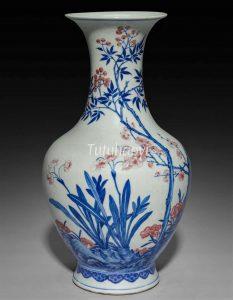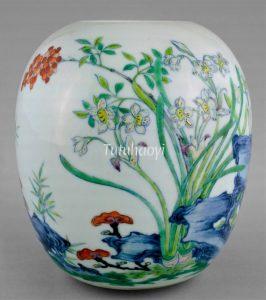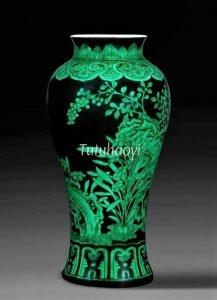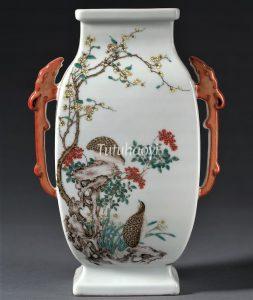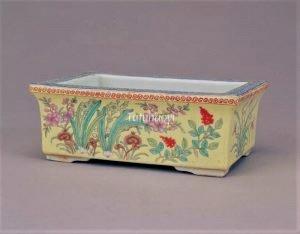Heavenly immortals and fairies are celebrating your birthday
天仙拱寿 (天仙祝寿)
© Tutuhaoyi.com owns the copyright of the description content for the images attached. Quoting all or part of the description content on this page is permitted ONLY IF ‘Tutuhaoyi.com’ is clearly acknowledged anywhere your quote is produced unless stated otherwise. (本页描述内容版权归Tutuhaoyi.com所有,转发或引用需注明 “Tutuhaoyi.com”, 侵权必究, 已注开源信息的条目除外。)
The Chinese character ‘tian 天’ from the phrase ‘tianzhu 天竹’ for ‘nandina’ is both a homophone and homograph of the character ‘tian 天’ for ‘heaven’. The character ‘xian 仙’ in the phrase ‘shuixian 水仙’ for ‘narcissus’, is both a homophone and homograph of the character ‘xian 仙’ for ‘immortal’ or ‘fairy’. The combination of the images of nandina and narcissus can be used to represent the concept of ‘tianxian 天仙’, i.e. ‘heavenly immortals or/and fairies’.
Garden Rocks, sometimes with characteristic holes in them, have a nickname ‘shoushi 寿石’, which means ‘longevity rock’ for being resistant to wear and tear and lasting in nature and thus are often used to convey the meaning of ‘shou 寿’ for ‘longevity’. Fungus lingzhi 灵芝 is also a motif symbolic for long life.
A composition comprising of the above-mentioned pictorial elements has traditionally been used by the Chinese to send good wishes to a birthday boy or a birthday girl.
Simply regarding these purposefully and beautifully arranged floral compositions as a botanical feast, as they are treated in some museum catalogues, would fall short of their creators’ thoughtful design.
Article written by Dr Yibin Ni
Related blogs:
Fig 1: porcelain dish with underglaze blue and overglaze enamelled decoration, Yongzheng period (1723–35), Qing dynasty, courtesy of Asian Art Museum, San Francisco
Fig 2: porcelain dish, painted in overglaze green enamel on a black ground, Yongzheng period (1723–35), Qing dynasty, courtesy of Cleveland Museum of Art
Fig 3: porcelain vase with underglaze blue and red decoration, Yongzheng period (1723–35), Qing dynasty, courtesy of the Cleveland Museum of Art
Fig 4: porcelain dish, Yongzheng period (1723–35), Qing dynasty, courtesy of Asian Art Museum, San Francisco
Fig 5: porcelain jar, Yongzheng period (1723–35), Qing dynasty, courtesy of the Art Institute of Chicago
Fig 6: porcelain vase, painted in overglaze green enamel on a black ground, Yongzheng period (1723–35), Qing dynasty, courtesy of the Dawentang Collection
Fig 7: porcelain vase with overglaze enamelled decoration and chi-dragon handles, Qianlong period (1736–95), Qing dynasty, courtesy of Cleveland Museum of Art
Fig 8: porcelain basin, Guangxu period (1875–1908), Qing dynasty, courtesy of Palace Museum, Beijing
Fig 9: Tian Xian Gong Shou Tu 天仙拱寿图, silk tapestry with cut designs, Chen Juzhong (active in Southern Song dynasty 1127–1279), courtesy of the National Palace Museum, Taipei


